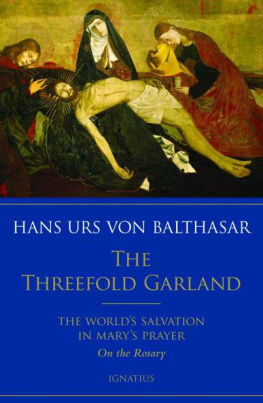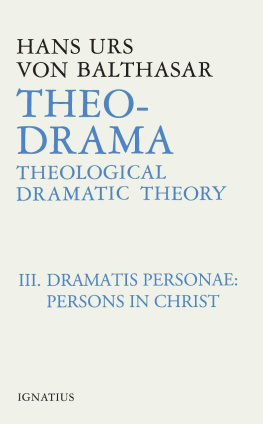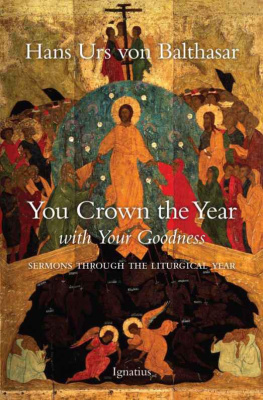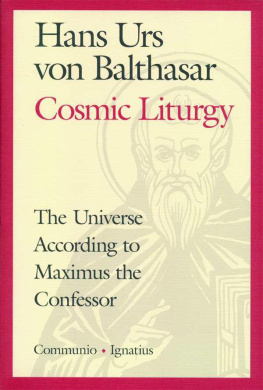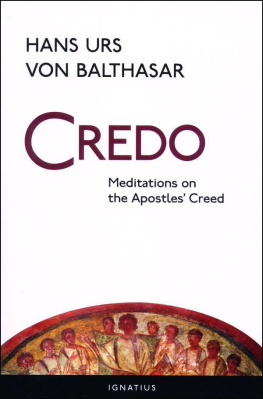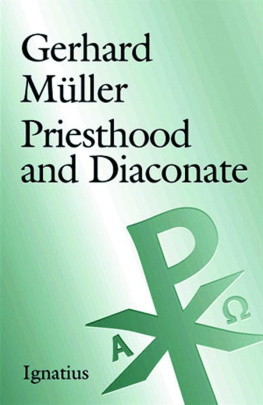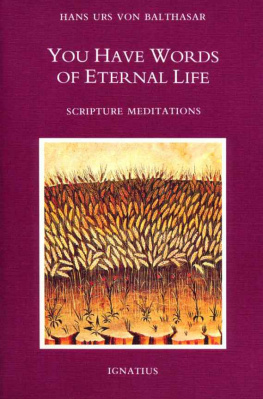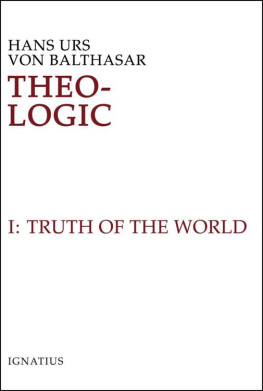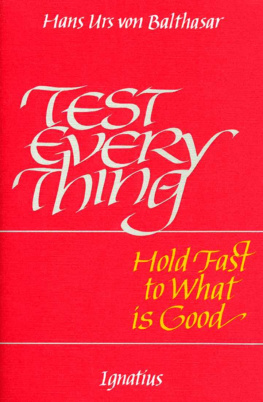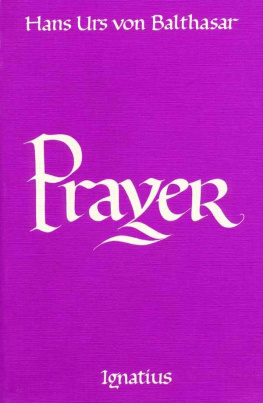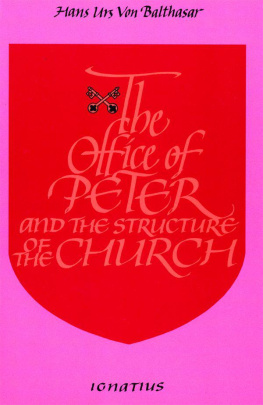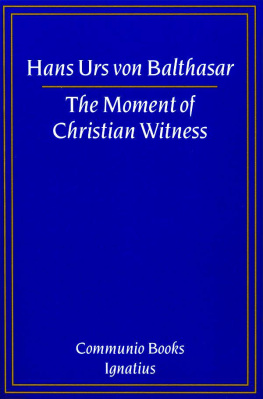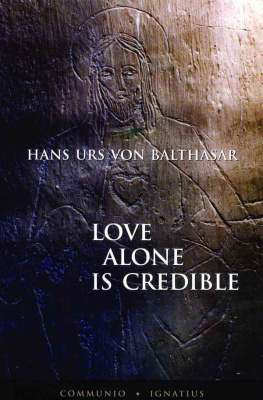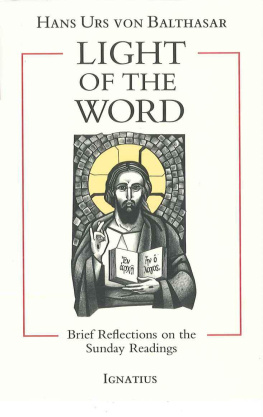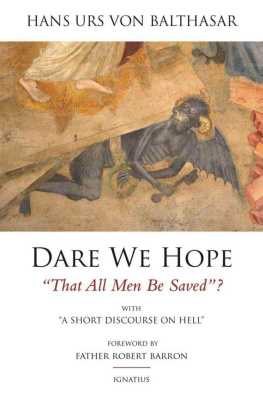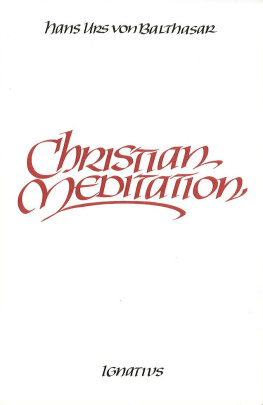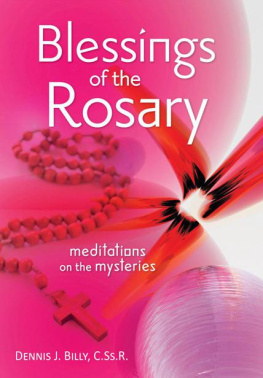Hans Urs von Balthasar - The Threefold Garland
Here you can read online Hans Urs von Balthasar - The Threefold Garland full text of the book (entire story) in english for free. Download pdf and epub, get meaning, cover and reviews about this ebook. year: 1982, publisher: Ignatius Press, genre: Religion. Description of the work, (preface) as well as reviews are available. Best literature library LitArk.com created for fans of good reading and offers a wide selection of genres:
Romance novel
Science fiction
Adventure
Detective
Science
History
Home and family
Prose
Art
Politics
Computer
Non-fiction
Religion
Business
Children
Humor
Choose a favorite category and find really read worthwhile books. Enjoy immersion in the world of imagination, feel the emotions of the characters or learn something new for yourself, make an fascinating discovery.
- Book:The Threefold Garland
- Author:
- Publisher:Ignatius Press
- Genre:
- Year:1982
- Rating:3 / 5
- Favourites:Add to favourites
- Your mark:
- 60
- 1
- 2
- 3
- 4
- 5
The Threefold Garland: summary, description and annotation
We offer to read an annotation, description, summary or preface (depends on what the author of the book "The Threefold Garland" wrote himself). If you haven't found the necessary information about the book — write in the comments, we will try to find it.
The Threefold Garland — read online for free the complete book (whole text) full work
Below is the text of the book, divided by pages. System saving the place of the last page read, allows you to conveniently read the book "The Threefold Garland" online for free, without having to search again every time where you left off. Put a bookmark, and you can go to the page where you finished reading at any time.
Font size:
Interval:
Bookmark:
HANS URS VON BALTHASAR
THE THREEFOLD GARLAND
HANS URS VON BALTHASAR
GARLAND

THE WORLDS SALVATION
IN MARYS PRAYER
TRANSLATED BY ERASMO LEIVA-MERIKAKIS
IGNATIUS PRESS SAN FRANCISCO
Title of the German original
Der Dreifache Kranz
1978 Johannesverlag
Einsiedeln, Switzerland
Cover art:
Pieta de Villeneuve dAvignon
Quarton, Enguerrand (1410-c.1464)
Louvre, Paris, France
Erich Lessing / Art Resource, New York
Cover design by Roxanne Mei Lum
With ecclesiastical approval
1985 Ignatius Press, San Francisco
All rights reserved ISBN 978-0-89870-015-2
Library of Congress Catalogue Number 81-83569
Printed in the United States of America
Jesus, whom you, O Virgin, conceived of the Holy Spirit
Jesus, whom you, O Virgin, took to Elizabeth
Jesus, to whom you, O Virgin, gave birth
Jesus, whom you, O Virgin, offered up in the temple
Jesus, whom you, O Virgin, found again in the temple
Jesus, who sweated blood for us
Jesus, who was scourged for us
Jesus, who was crowned with thorns for us
Jesus, who bore the heavy cross for us
Jesus, who was crucified for us
Jesus, who rose from the dead
Jesus, who ascended into heaven
Jesus, who sent us the Holy Spirit
Jesus, who took you, O Virgin, up into heaven
Jesus, who crowned you, O Virgin, in heaven
To read most any work of Hans Urs von Balthasar is to plunge into a bright ocean where the most familiar truths and events of faith take on a freshness and a splendor usually hidden from our dull vision. The chief instance of this in the present volume is perhaps the astounding meditation on the mystery of the Lords Finding in the Temple by Mary and Joseph. To many this could seem a relatively minor event in the Gospel narrative, and yet to von Balthasar it affords the opportunity of developing a whole theology of the ascetic life in a nutshell.
This theologian never discusses theology as one might some interesting topic, with that erudite chattiness so common to modern theologians and which so quickly wearies the reader. Rather, it is Father von Balthasars particular mission in the Church as theologian to invite us to enter into his own untiring contemplation of the mysteries of faith. His is a theology that not only derives from prayer and leads back to prayer, but one whose natural element and very life-blood is prayer. He does not construct propositions and theses to provide us with a theological method of approach; rather, he teaches us to see what he sees and to love what he loves, and why. He never raises himself or his profession above the object of theology, for he knows only too well that it is this Object itselfGods being and his actions with manthat determines the attitude, the work and the mission of the theologian, who in the end is nothing but a believer striving for ever-greater understanding and clarity concerning the things the Church has already taught him to know and to love.
The little book we here offer is a classical demonstration of the fact that the profoundest truths need not always be expressed in a technical or esoteric terminology for them to retain all their depth. Far from that: it is the simplicity of the well-chosen image, the directness of a sudden intuition, the whisper of a sentiment too delicate for words, that often best preserve and convey the whole range of intended meaning. A certain genius is needed to compress great richness into great simplicity, and in my opinion this book, without diluting it, contains the essence of von Balthasars weightier tomes; and this is so, I may add, not in spite of the fact that the style here is non-technical, at times poetic and always full of prayer, but precisely because of these qualities. For this reason I would recommend these thoroughly accessible pages as perhaps the best possible introduction to the overwhelming and sometimes difficult work of Father von Balthasar. The long philosophical excursus and slow-motion expositions required elsewhere in his work are often the measure of his titanic effort in trying to bring the mind of the world, the imbalances of a given cultural epoch and the exigencies of reason a bit closer to the warmth and the life emanating from the loving Heart of God. But at the center, at the point vierge , this Hearts mystery itself is utterly crystallineinvisible and unproblematic as the very air we breathe.
Surely one outstanding trait of von Balthasars thought is what I would call its concentric vision. By this I mean that he never treats a subject in isolation from all those other subjects which are naturally bound to it, but sees them as interacting concentric circles, distinct yet inseparable and springing from a common center. The unity of the Paschal Mystery is certainly the determining source of this vision (presence of the cross at the crib, the Lords glorification in his death out of love...); and, in extending this principle of concentric unity to all the mysteries of faith, von Balthasar is not merely trying to be methodologically consistent or original, but is exhibiting his theological obedience to the actual manner God has chosen to redeem man, a manner reflecting the very interior nature of God himself.
And so we have before us both the circle representing the reality of Christ and the circle of Mary, by divine choice utterly inseparable from one another. You are wider than the heavens, the Eastern liturgy sings to the Holy Virgin, for within yourself you have confined the unconfinable God. The question as to which circle contains which is as old at least as the Council of Ephesus (431): the Creator by his nature contains his creature, Mary, who by grace comes to contain the Creator! This, the essential paradox of Christianity, receives a terser, more Latin formulation from St. Catherine of Siena, who in her Dialogue on Divine Providence exclaims to her Lord: We are Your image and You are our image (IV, 13). The traditional iconographic representation of this mystery of awesome exchange teaches the dogmatic truth most graphically. The icon known as Our Lady of the Sign (sign here referring to the prophecy of Isaiah to Achaz) shows Mary offering Christ to the world from a mandorla on her breast, that is, from a window to heaven consisting of concentric circles and out of which appears the Savior. The Virgin herself, in turn, is surrounded by a greater mandorla. Our Lady becomes the Theotokos the conceiver, the bearer, the nurturer of Godnot by a law of nature or of logic nor by the design of men, but because of the humble omnipotence of the Philanthropos Kyrios , the divine Lover of Mankind who, says St. Irenaeus, can make himself subject to his creature because, in him, compassion and omnipotence coincide ( Adversus haereses III, 24).
In this sense The Threefold Garland is a companion volume that completes Heart of the World , also by Father von Balthasar and an earlier publication of the Ignatius Press. If Heart is a book about the love of the Redeemer for fickle man, about the human and suffering face and Heart of God, then the Garland is about the human Mother who gave God his Heart and thus made Gods sufferingand the redemptionpossible. The uncreated Lord cannot have a mother; the redeeming Lord must. And, because there are not two lords but one Lord, Mary unexplainably becomes both the Mother of God and the Mother of all those redeemed by the incarnate God, who wills that man should receive from Mary the life he has deposited in her corporeally. But because this life is actually himself, no one can be found in Christ who is not also found in Mary.
It is quite characteristic of von Balthasars theology that his book about Mary should approach the Mother of God exclusively in her relationship to the redemptive mysteries of her Son. Without ever becoming polemical, von Balthasar illuminates the mystery of Marys divine motherhood in a manner that should dispel Protestant fears of alleged Catholic and Orthodox Mariolatry. The books subtitle (the worlds salvation in Marys prayer) at once provides the basis for all true Mariology: the Churchs and the individual Christians prayer to Mary is a movement towards Mary, towards the place of holiness Mary already occupies. Thus, Marian prayer (whether this means prayer to Mary or in the manner of Mary) is but the practical means of entering into and participating in the reality which Our Lady already embodiesthat of being the handmaid of the Lord even (and especially!) in her glorification. By her very nature, Mary is incapable of being an end in herself. Nevertheless, this rather re-enforces than diminishes her role in the economy of redemption. Already in the second century, at the very dawn of Christian theology, we find St. Irenaeus combatting the Gnostic tendency to spiritualize and rationalize the central mystery of the faith, the Incarnation, to the point of its evaporation. And the vigorous bishop of Lyons binds together all his other arguments concerning the hard reality of the Lords humanity and its redemptive effects by declaring that, through her obedience and her resulting conception of the Son of God, the Virgin Mother became the cause of salvation both for herself and for all of mankind ( : III, 2). Mary already is what we may be , and being the physical Mother of the God-Man she provides the indispensable chamber for the espousals of God and man. God does not erase the paths he has once traced, and thus he cannot will for us to become sanctified, which is to say divinized, other than in the place where he himself became human: in the humble shrine of the Virgins obedient heart.
Next pageFont size:
Interval:
Bookmark:
Similar books «The Threefold Garland»
Look at similar books to The Threefold Garland. We have selected literature similar in name and meaning in the hope of providing readers with more options to find new, interesting, not yet read works.
Discussion, reviews of the book The Threefold Garland and just readers' own opinions. Leave your comments, write what you think about the work, its meaning or the main characters. Specify what exactly you liked and what you didn't like, and why you think so.

